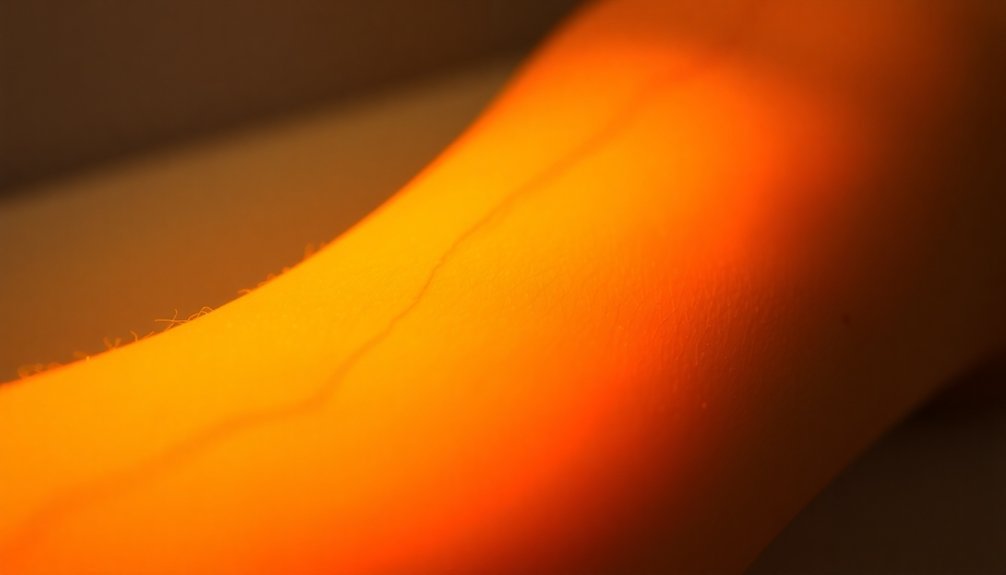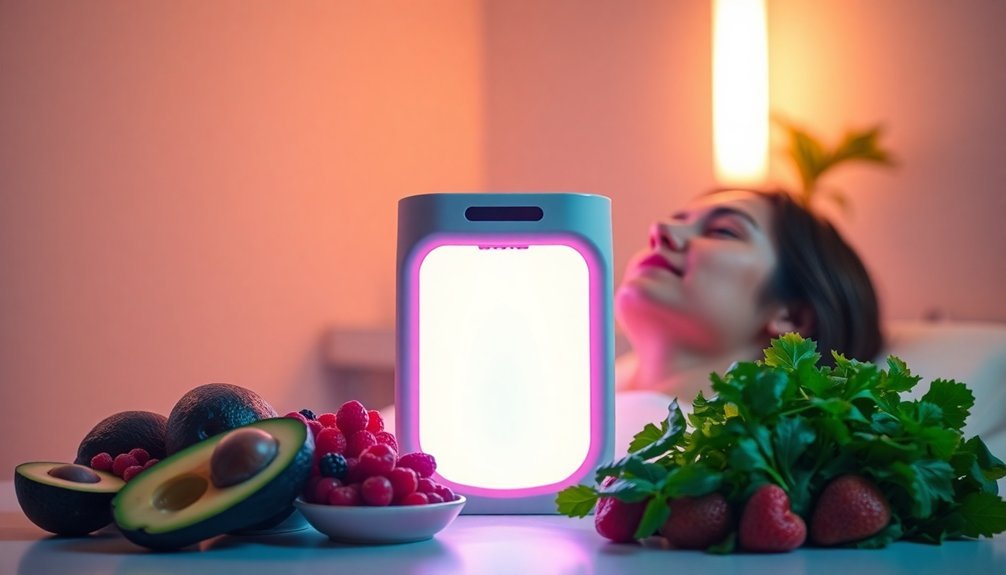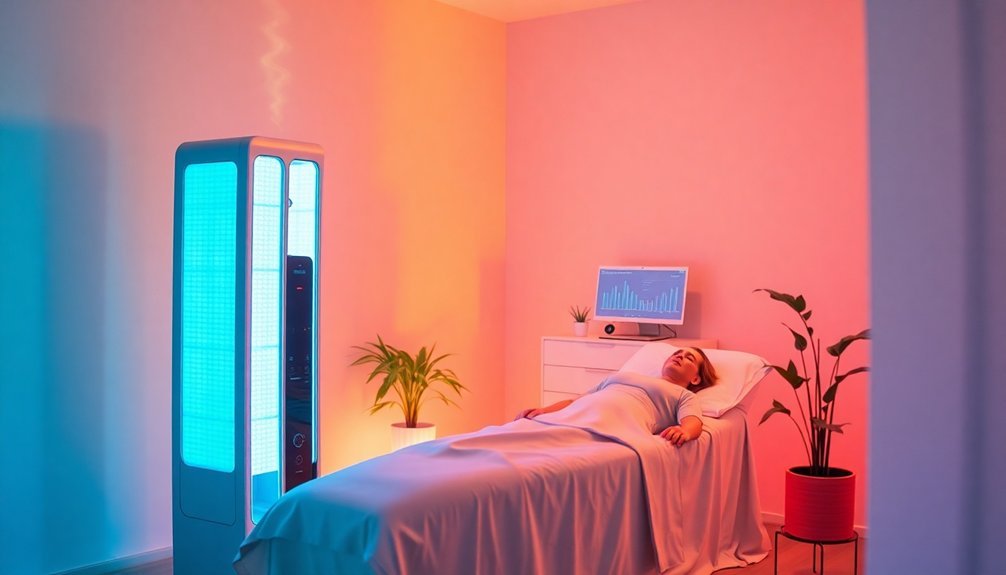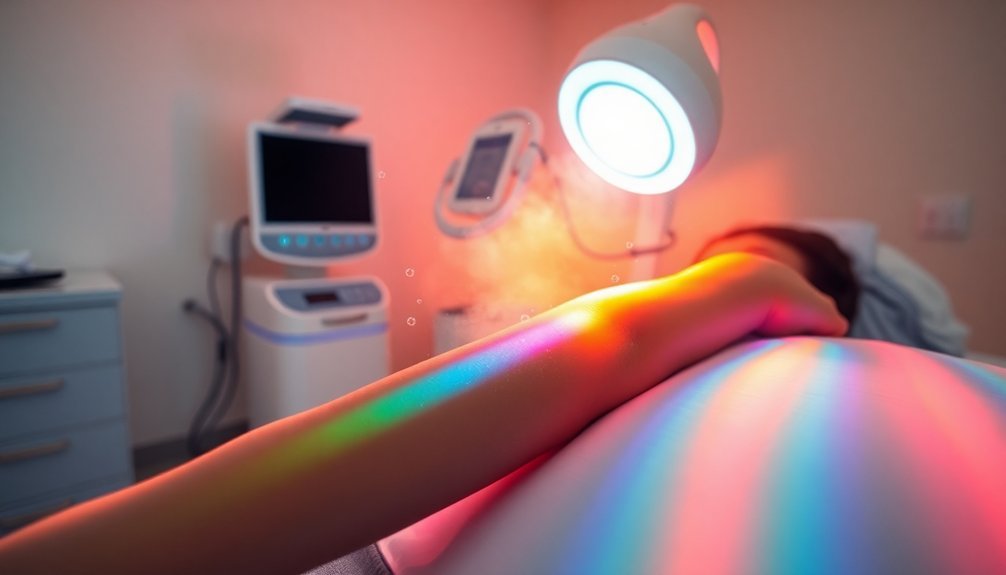Phototherapy fights dangerous arterial buildup in five vital ways. First, it enhances cellular energy production by boosting ATP levels, which supports metabolism. Second, it promotes nitric oxide release, improving blood flow and circulation. Third, it reduces inflammation and cholesterol within arterial plaques, targeting inflammatory cells effectively. Fourth, phototherapy improves blood flow through vasodilation, allowing better nutrient delivery. Finally, it offers a safe alternative to invasive treatments, minimizing recovery time and risks associated with surgeries. These benefits highlight how powerful light therapy can be for your cardiovascular health, and you might find the full range of effects even more interesting.
Enhances Cellular Energy Production

Phototherapy effectively enhances cellular energy production by directly stimulating mitochondrial function. When you expose your cells to this specialized light treatment, it targets the Cytochrome C complex in your mitochondria. By absorbing light, Cytochrome C oxidase (COX) ramps up activity in the electron transport chain, leading to increased ATP production. More ATP means better energy balance and improved cellular metabolism.
Increased ATP synthesis is essential for important cellular processes. You'll find this boost in energy not only helps restore balance in damaged tissues but also supports various activities, including DNA synthesis and cellular signaling. With enhanced mitochondrial function, you can prevent cell death and reduce inflammation, leaving your tissues better equipped to heal.
Additionally, phototherapy modulates reactive oxygen species (ROS) levels, balancing them to maintain overall cellular health. This modulation leads to faster cellular signaling and further supports tissue repair. This process also enhances micromodulation of inflammation**, potentiating the healing effects even further.
Promotes Nitric Oxide Release
Through the application of specific wavelengths of light, you can promote the release of nitric oxide (NO) in your body, a process that offers significant health benefits. When you expose your skin to UVR and blue light, your body can convert stored compounds into NO.
In addition, red and near-infrared (NIR) light stimulate the mobilization of NO stores stored in the skin, initiating a non-enzymatic release. This photolytic reaction efficiently sends NO derivatives into your bloodstream, contributing to lower blood pressure. Recent research highlights that DPP-NF nanoparticles utilize NIR light to achieve controlled NO release, enhancing therapeutic efficacy.
As NO levels rise, you experience local vasodilation, which enhances blood flow to essential nerves and tissues. This effect can last for several hours, promoting healing and relieving pain.
The physiological benefits extend beyond blood circulation; NO release also balances the NO:ET-1 ratio, assisting in the regulation of blood flow.
When light therapy is applied, LED treatments specifically trigger NO release from blood vessels and red blood cells, further aiding in nerve cell perfusion and oxygenation.
Reduces Inflammation and Cholesterol

When inflammation and cholesterol build up in your arteries, it increases the risk of serious cardiovascular events. Fortunately, photodynamic therapy (PDT) offers a powerful strategy to tackle these issues. By utilizing light-activated substances, PDT targets inflammatory macrophages within plaques, reducing inflammation and promoting plaque stability. It also employs advanced materials like carbon nanoparticles to enhance the immune system's ability to clear away dead cells that contribute to plaque buildup. Recent findings indicate that intra-arterial PDT provides a method for rapid accumulation of photosensitizers in plaques, which further enhances treatment efficacy.
Here's a quick overview of how PDT reduces inflammation and cholesterol:
| Mechanism | Effect | Outcome |
|---|---|---|
| Increases ROS | Induces apoptosis in macrophages | Reduces inflammatory cells |
| Targets cholesterol-rich plaques | Cytotoxic effects on lipids | Lowers cholesterol content |
| Enhances efferocytosis | Clears dead cells from plaques | Prevents plaque growth and rupture |
| Focused local delivery | Minimizes systemic side effects | Enhances treatment efficiency |
| Combines with PCI | Treats longer artery segments | Reduces risk of restenosis |
Improves Blood Flow Through Vasodilation
You might be surprised to learn how effectively light therapy can improve blood flow by inducing vasodilation in your arteries. Both laser and LED light sources trigger this process, leading to greater blood flow in the coronary arteries.
The mechanism involves an intracellular response that relies heavily on nitric oxide. This compound plays a crucial role in the vasodilation process, allowing your blood vessels to widen and subsequently increasing blood flow.
You should also know that specific energy densities, such as 10 J/cm² for laser light, are ideal for achieving maximum vasodilation. Notably, the endothelium's state doesn't hinder this effect, indicating that vasodilation can occur independently of endothelial cells.
As a result, you'll experience improved skin circulation and cutaneous hyperperfusion, which enhances overall blood distribution. While increased blood flow happens at the skin's surface, it may slightly decrease blood supply to other areas like the renal and mesenteric systems.
This process is fundamental, as it guarantees more effective nutrient delivery and regulates your cardiovascular health efficiently. By embracing phototherapy, you're choosing a method that promotes better vascular function through natural mechanisms in your body.
Offers a Safe Alternative Treatment

Phototherapy emerges as a groundbreaking alternative treatment for arterial buildup, providing a less invasive option compared to traditional procedures. This innovative approach minimizes invasiveness, reduces the risk of complications, and enhances overall safety, making it a compelling choice for patients.
- It uses light-activated drugs, which decreases the need for surgical interventions.
- The method avoids the insertion of balloons or stents common in angioplasty, leading to fewer risks and a simpler experience.
- With minimal trauma to blood vessels, recovery time is considerably shorter than with invasive methods.
Moreover, phototherapy effectively targets plaque by utilizing lutetium texaphyrin, which shrinks plaque deposits and reduces inflammation in arterial walls.
Early studies also suggest it may prevent scar tissue formation, avoiding the usual restenosis associated with conventional treatments.
You can undergo this procedure with less associated risk, as it's described as "not hazardous" and involves careful monitoring throughout.
By opting for phototherapy, you not only decrease recovery time but also embrace a treatment known for its safety and effectiveness across various patient groups.
This makes it a promising avenue for managing arterial buildup without the burdens of traditional interventions.
Frequently Asked Questions
How Often Should RLT Be Used for Best Results?
To achieve the best results with red light therapy, you should start with 2-3 sessions per week. Consistency's key, so adjust frequency based on your response and always follow your healthcare provider's guidance.
Are There Any Side Effects Associated With RLT?
Yes, there are side effects associated with red light therapy, including headaches, skin irritation, and eye strain. You should follow usage guidelines closely and consult a healthcare provider if you have specific health concerns.
Can RLT Be Used Alongside Medications?
You can't currently combine red light therapy with medications for treating arterial buildup. Research primarily focuses on standalone therapies, highlighting the need for more studies to explore any effective combinations and enhance treatment outcomes.
How Long Does Each RLT Session Typically Last?
Each RLT session typically lasts between 10 to 20 minutes, depending on your specific treatment goals. Sessions may vary in duration, especially for pain relief or skin rejuvenation, so adjust according to your needs.
Is RLT Effective for All Age Groups?
Yes, red light therapy's effective for all age groups. Younger individuals usually respond quicker, while older adults may need extended sessions, but benefits like improved skin health and reduced inflammation can be experienced by everyone.
In Summary
To sum up, phototherapy offers a powerful approach to combatting dangerous arterial buildup through its ability to enhance cellular energy, promote nitric oxide release, reduce inflammation, improve blood flow, and serve as a safe alternative treatment. By embracing this innovative therapy, you can support your heart health and overall well-being. It's time to explore how phototherapy can make a positive impact on your life and take charge of your cardiovascular health today!





Leave a Reply